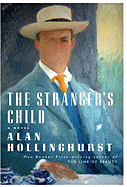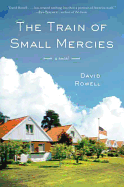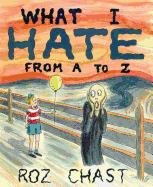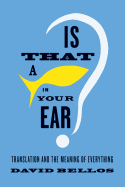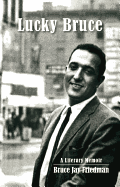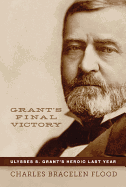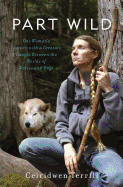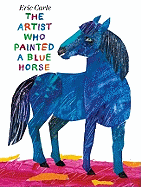Tuesday, October 18, 2011
In the book industry, we often use the phrase "handseller." It's a book that doesn't necessarily have a huge promotional budget but is successful because booksellers, librarians and publishing folk get behind it, seek out readers for it and hand copies to them one by one while insisting, "You have to read this." Seeing exceptional books find the audience they deserve in this way is one of the most rewarding things that can happen in the book world.
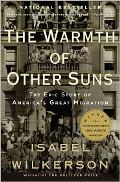
Read these books, get them to your friends and then you will experience the joy of handselling, too. --Jenn Risko
The Train of Small Mercies
by David Rowell
The Train of Small Mercies, David Rowell's first novel, unfolds on June 8, 1968, the day of Senator Bobby Kennedy's funeral, focusing on the passage of his funeral train as seen by six unrelated, "ordinary people," each of whom is fighting a personal inner battle as well as expecting or dreading the passing of the train through their lives. Rowell's cast includes a 10-year-old boy still nursing confusion over his parents' divorce and a housewife trying to sneak out of the house long enough to bid Kennedy goodbye. There's also an Irish immigrant facing the prospect of losing her interview for a nanny position with the Kennedy family, and a Pullman porter whose first day of work is on the train to Washington, D.C., carrying the assassinated presidential candidate to his final resting place.
Rowell captures a truth about public grief in America: when we lose a public figure, we may grieve in concert, but we do not do it together. Each of the six characters is aware that seeing the Kennedy train pass is a group event; none of them experiences that moment physically alone. Yet all six find, at that moment, that they are isolated within their own minds in a way that merely gathering in a crowd cannot remedy. The Train of Small Mercies captures the individual yet quintessentially human experience of grief. --Dani Alexis Ryskamp, blogger at Intractable Bibliophilia
Discover: A glimpse into the lives of six ordinary people provides depth and humanity to an extraordinary day in American history.
The Stranger's Child
by Alan Hollinghurst
There's an exhilarating sense of truthfulness watching Alan Hollinghurst's characters interact and grow old in his new masterpiece, The Stranger's Child. With a serpentine, multi-branching plot spanning almost 100 years, the reader watches children change into doddering elder folk, opinions reverse and morph, reputations rise and grand houses fall. Along the way, Hollinghurst teases and fools the reader, playing with the traditions of the classic British novel, all in his trademark gorgeous prose.
The tale begins with 16-year-old Daphne Sawle becoming infatuated with Cecil Valance, a wealthy young poet who at Cambridge has become the friend of her older brother. Cecil is visiting the Sawle home, Two Acres, where he will write his most famous poem. Then the First World War erupts, wrecking lives and scattering the characters, and their secrets become the mysteries that perplex their biographers years later.
With a cast ranging from servants to baronets, piano teachers to bankers, the story moves forward for the most part through social events--a guest at the family home; a party honoring Cecil Valance; Daphne's 70th birthday. Suspense lurks just beneath the surface of this glossy, privileged world of rigorous conventions and repressed passion, and can break out on a pretext as thin as the children's piano-and-dance performance being stopped by their angry father, a scene that explodes with emotional violence.
Some dozen years pass between Part One and Part Two. Part Three begins in 1967 in a bank at closing time. With each new part, the reader, like a time traveler, is catapulted forward and dropped down without ceremony into the story a number of years hence, trying to figure out what has happened to the characters left behind. Puzzling it all out makes for gratifying literary sport, filled with cunning surprises.
The Stranger's Child is the most challenging, perceptive, labyrinthine, hugely satisfying fiction entertainment since--well, since Hollinghurst's The Line of Beauty, which won the 2004 Booker Prize. Hollinghurst serves up one great big banquet of a book, with plenty of the cruelty and sting of the real world, the irrationality of lust, the fickleness of fame, unanticipated deaths--and unexpected, priceless moments of compassion and grace. --Nick DiMartino, Nick's Picks, University Book Store, Seattle
Discover: Literary tricks and surprises abound as Hollinghurst follows several dozen characters through almost 100 years of hidden passionate friendships and secret loves.
Graphic Books
Dear Creature
by Jonathan Case
Lusts of the flesh, hungers of the soul, Shakespeare's immortal language and Cold War-era fear of "the other" merge in this gruesome, literate, wacky and charming graphic novel from Portland artist and writer Jonathan Case. A love story between a flesh-craving sea mutant and a fragile agoraphobe, Dear Creature combines sci-fi horror with wit and whimsy. Creepily original yet nicely evocative of both the themes of atomic-era America as well as its comics, Case's debut is a perfect marriage of storytelling and art.
Case depicts a California coastal town in the era of beehive hairdos and skinny ties, where Grue, a humanoid sea creature--created by atomic accident, natch--feasts upon the amorous teens always so plentiful at the water's edge. Bits of Shakespeare stuffed into floating soda bottles lead Grue to Giulietta, a post-war Italian immigrant trapped by anxiety on her family's docked boat. Strange, beautiful love ensues and Grue swears off the teen-eating, but the townsfolk are raising a ruckus about the murders and Grue must save Giulietta's scapegoated family to be worthy of her love.
Case's art employs a black-and-white realistic style that harkens back to classic romance and superhero comics but also to David Lapham's hyper-violent Stray Bullets. Likewise, the themes of predation and sex panic resonate with the story's time period but its wry, ironic tone and homicidal anti-hero are wholeheartedly modern. The love story of Grue and Giulietta is funny and horrible, sweet and repulsive, brilliantly drawn and told: an amazing debut. --Cherie Ann Parker, freelance journalist and book critic
Discover: A stunning debut graphic novel mixing an inventive mutant creature story with retro comic realism.
What I Hate: From A to Z
by Roz Chast
We all have fears, neuroses and pet peeves. And there's no one else on earth who can better capture and articulate such absurdities of the human psyche than New Yorker cartoonist Roz Chast. In What I Hate: From A to Z, Chast, a self-proclaimed "anxious person," brings her own special brand of wry humor and artistic style to a clever, alphabetized catalogue of her favorite personal anxieties and concerns. Chast utilizes all 26 letters of the alphabet, and offers runners-up and understudies at the end of the book, striking a perfect balance between the literary and the visual. Each full-page cartoon entry, and brief passage of accompanying text, resonates with insight and wit about the human condition. Rendered via Chast's cerebral point of view, common fears--elevators, getting lost, heights, nightmares, and waterbugs (to name just a few)--are cast in a chilling new light, while her treatment of more eccentric, highly specialized concerns--alien abduction, carnival ride maintenance, Jello, Ouija boards, premature burial, undertow and the color yellow--is full of irony as well as dark, intellectual depth.
Chast is a meticulous illustrator, yet a charming simplicity reigns as the hallmark of her work. The unique, sketchy quality of her art is what makes it so appealing to a wide, crossover audience, but the content of these cartoons can evoke deeper thoughts even while inspiring the reader to laugh out loud. --Kathleen Gerard, blogger at Reading Between the Lines
Discover: A brilliant illustrator's hilarious take on an assortment of personal anxieties.
Nonfiction
The Myth of Choice: Personal Responsibility in a World of Limits
by Kent Greenfield
As Kent Greenfield (The Failure of Corporate Law) notes near the beginning of The Myth of Choice, American culture has put an increasingly high value on the importance of choice in nearly every arena of modern living. You can "have it your way" at Burger King, while perusing options for health insurance on your customized smartphone, which also offers the ability to watch thousands of movies via Netflix, or choose from your entire lifetime's collection of songs saved in Google Music--and so on.
Readers interested in the means and methods of how we make decisions--and how we perceive ourselves as immune to attempts at influencing those decisions--will find Greenfield's book an embarrassment of riches. Applications of the idea of choice vary widely, from a consideration of the question--not the answer, but the question--of whether sexual orientation is a choice, to the ramifications of laws around whether or not motorcyclists have a choice about wearing helmets. How much choice do we grant our children, knowing that too much autonomy can lead to situations where the child has to relinquish that autonomy and doesn't, while also knowing that not enough autonomy can lead to too much dependence, to an underdeveloped sense of a child's strengths and weaknesses? How are habits choices, and how are they not? Greenfield pulls from sociology, law, popular culture, history and reason, with essays that strike a perfect balance of erudition and down-to-earth consideration of responsibility. --Matthew Tiffany, counselor, writer for Condalmo
Discover: A fascinating, engaging dissection of the meanings and implications of choice in a wide variety of cultural arenas.
Is That a Fish in Your Ear?
by David Bellos
"Nowadays there are only about fifty languages [out of a possible 7,000] between which imports and exports of translated books occur with any regularity," Bellos tells us, noting that English, French and German still lead the pack. He spins out a dazzling essay on the ineffable qualities of languages, attempts to capture and communicate nuance across tongues, and explains the dangers of not questioning the source of highly quotable zingers.
Issues of "literal" versus "general sense" translations emerge in the essay "Bibles and Bananas," about the unavoidable choices made when the Bible has been rendered into some 2,500 languages. What happens when a version is a translation of a translation? What if the translator is more concerned with transmitting the story than the precise sacred script of the original?
Literary translations aside, consider the challenges when questions of law have to be communicated across languages. The Nuremberg Trials in 1945, U.N. language requirements and European Economic Union procedural rules created a demand for simultaneous translations that go far beyond the skills of legal counsel who interpret clauses of international trade contracts.
As Bellos so eloquently shows, a language and its translations into other languages make us not only human and stylish but civilized. --John McFarland, author
Discover: A raft of witty, illuminating and penetrating essays on translating a single clear utterance from one language to another with clarity and force.
Biography & Memoir
Lucky Bruce
by Bruce Jay Friedman
Bruce Jay Friedman (at least the one in Lucky Bruce) appears to be the quintessential self-absorbed, self-deprecating smart Jewish guy from the Bronx. Reading his memoir is like watching a Woody Allen film festival--back-to-back stories of lust, overbearing mothering, serial psychoanalysis, namedropping, boot-strapping literary success... and very funny lines.
Friedman did not achieve his mother's ambitious plan for his career in "theatrical public relations," nor her second choice, medicine ("Why someone would choose to become a writer--and not a dermatologist--mystified her."). Instead, his career launched from the dark corridors of Magazine Management Co. (where he put the finishing touches on prison, war and soft-porn stories for magazines such as Swank and Male) to seeing his stories in the New Yorker; publishing his first of eight novels, Stern, with Simon & Schuster, and then producing a portfolio of plays and screenplays that made him some money, made him a wide circle of connected friends and briefly made Natalie Wood his secretary.
Friedman kicked around New York and Hollywood, where he hit some home runs with Splash and his Lonely Guy franchise of books and movies. He has stories to tell about everyone he met along the way: literary heavyweights Mailer, Heller and Puzo; Law & Order's secret weapon, Jerry Orbach; movie lions Woody Allen and Warren Beatty... he knew them all. But at heart he was a writer. "Los Angeles was a toy store. The real world, i.e., the literary world, was in Manhattan." --Bruce Jacobs, founding partner, Watermark Books & Cafe, Wichita, Kan.
Discover: The free-wheeling memoir of a very funny but under-appreciated writer of fiction, plays and screenplays.
History
Grant's Final Victory: Ulysses S. Grant's Heroic Last Year
by Charles Bracelen Flood
Ulysses S. Grant's Personal Memoirs is recognized as one of the classics of military literature, not just in American letters but in all of history. Yet it might not have been written at all, except for the tragic circumstances that Charles Bracelen Flood recounts so concisely in Grant's Final Victory.
In the spring of 1884, Grant was doing as well as any former president might hope for: he'd taken his wife on a two-year world tour after leaving the White House and had settled in New York City, where he served as a partner in a Wall Street investment firm. Then he was hit with two disasters in quick succession: the firm's other founding partner absconded with all the funds, leaving Grant and his family near-broke, and shortly afterward Grant was diagnosed with throat cancer. Though he had always expressed reluctance in writing about his Civil War experiences, Grant agreed to write a series of articles, which he would then expand into a book, in order to clear his debts and provide for his family's future.
Flood, the author of a previous book about Grant's role in the Civil War, synthesizes a wide range of personal recollections, newspaper accounts and other historical sources into a modestly straightforward account of Grant's effort to finish his memoir before succumbing to his disease. But it's not just the story of Grant's interactions with his family and his publishers (including Mark Twain). Flood also considers how the news of Grant's impending death affected the nation; the expressions of love and respect from American citizens, including Confederate veterans, offer some of the book's most touching details. --Ron Hogan, founder of Beatrice.com
Discover: A deceptively brief but inspiring account of how, in the midst of tragedy, Ulysses S. Grant found the strength to write one of America's greatest memoirs.
Ghost on the Throne: The Death of Alexander the Great and the War for Crown and Empire
by James Romm
Over the span of 13 years, Alexander the Great created an empire that stretched from Macedonia to India, only to die before he could arrive home to enjoy what surely would have been a hero's welcome. In Ghost on the Throne, classicist James Romm focuses on the struggle for power that followed Alexander's death.
On his deathbed, legend has it, Alexander bequeathed his empire "to the strongest." With a challenge like that, it's no wonder Alexander's vulnerable heirs--his half brother, Philip III, and his son, Alexander IV--wound up being exploited by the Macedonian generals hoisting themselves into positions of power. None of these generals stands out more than Eumenes, Alexander's former secretary, but although he was cunning and shrewd in his alliances, even he could not keep the Macedonian empire together as former allies began to turn on one another.
While Romm's vividly described depiction of the aftermath of Alexander's death is clearly the result of scholarly research, it is accessible for a general audience. His dynamic storytelling brings this ancient period alive in cinematic detail; coupled with the captivating cast of characters, Ghost on the Throne is a relentless and absorbing read. --Sarah Borders, librarian, Houston Public Library
Discover: The fascinating story of what happened to Alexander the Great's empire after his untimely death.
Pets
Part Wild: One Woman's Journey with a Creature Caught Between the Worlds of Wolves and Dogs
by Ceiridwen Terrill
Readers who believe wolves are really just dogs--only wilder--will be enlightened by Ceiridwen Terrill's experience raising Inyo, a "high content" wolfdog whose father was 100% wolf and mother was 75% wolf and 25% Husky. Terrill illustrates the challenges of raising a creature outside of its natural habitat and integrates fascinating research into her tragic love story.
Terrill, an associate professor of science writing and environmental journalism, narrowly escaped an abusive relationship and sought a canine companion that would not only share her passion for rugged backcountry hiking, but could serve as a protector. More important, Terrill wanted to find a canine partner with a strong instinct for self-preservation, unlikely to please or to forgive harmful intentions, as Terrill had done in the past.
Enter Inyo--a wolfdog pup whose first breath came as a result of Terrill's assistance. However, Terrill soon realizes, "Inyo could not be my guardian. Instead I was hers. Not only did I have to shield her from the world, I had to shield the world from her." Terrill raises Inyo to the best of her abilities, forms a deep bond with her "part wild" companion, and shares her experiences in a memoir that is impossible to put down, even as it breaks the reader's heart.
Terrill uses extensive research to provide a well-rounded portrait of the realities of wolfdog ownership. Eventually, she realizes that "to love dogs is to keep them close. To love wolves is to leave them wild." --Kristen Galles from Book Club Classics
Discover: A heart-breaking adventure story about the joys and challenges of owning a wolfdog.
Children's & Young Adult
The Artist Who Painted a Blue Horse
by Eric Carle
As with most of Eric Carle's work, this beautifully conceived picture book is deceptively simple.
"I am an artist and I paint...," the book begins. A boy applies blue paint to a virgin gold background. His palette of many colors appears on a gray table beside him. A turn of the page reveals the completed composition: "a blue horse" with a black mane. He follows with a painting of a red crocodile against a white background with a band of teal blue at the top to indicate its aquatic habitat. Next comes a saturated portrait of a yellow cow. Carle fills the background with deep dark blues and greens, and dots the sky with stars. The golden hues of the cow pulse against the night sky. Thus he introduces the three primary colors: blue, red and yellow.
But this is not an art lesson in the standard sense; he doesn't follow next with binary and tertiary colors (though they do appear here). Carle's book urges children to break the rules when it comes to creativity. He stays true to the animals' musculature and defining features, then populates the pages with a pink rabbit, a black polar bear and a polka-dotted donkey.
This book (which Carle calls an "homage to Franz Marc," who painted Blue Horse I at the turn of the 20th century) teaches children to trust their own unique perceptions, and to render the world as they see it. Know the rules, Carle seems to say, and then make them yours. --Jennifer M. Brown, children's editor, Shelf Awareness
Discover: A true-life example of an artist who models originality, from the creator of The Very Hungry Caterpillar.
The Scorpio Races
by Maggie Stiefvater
This riveting novel by Maggie Stiefvater (the Wolves of Mercy Falls trilogy) explores loyalty, love and the strength needed to challenge long-held beliefs.
What happens when 2,000-pound flesh-eating horses rise out of the sea? On Thisby Island, they are harnessed and ridden in the thrilling and deadly Scorpio Races every November. Sean Kendrick's father died nine years ago while riding one such water horse. Now 19 years old, Sean is a four-time winner of the Races, and a genius with horses of all kinds.
Puck Connolly and her two brothers have also been orphaned by one of the capaill uisce (pronounced "copple ooshka"), the water horses. Puck rides in the Scorpio Races to keep her oldest brother from leaving for the mainland, and for the chance to win enough prize money to keep their house. She is the first female ever to ride in the Races, and the only one to ride an island pony, rather than one of the capaill uisce. Sean rides for ownership of his beloved Corr, a blood-red water horse, the very one his father was riding when he was killed. Sean also rides for a house and a stable of his own. But Sean and Puck also ride for love.
In spare, haunting prose, the author describes the bleak yet magical island landscape. Readers will root for Sean and Puck, rivals who learn to trust and care for each other through the course of the racing season. Stiefvater has crafted another winner, one you may well want to read all over again. --Lynn Becker, host of Book Talk, the monthly online discussion of children's books for SCBWI.
Discover: The terrifying beauty of Thisby Island, where the annual Scorpio Races test the island's bravest men--and one young woman.


